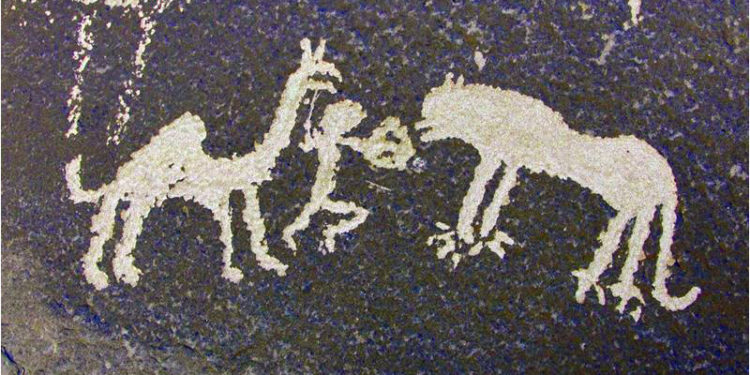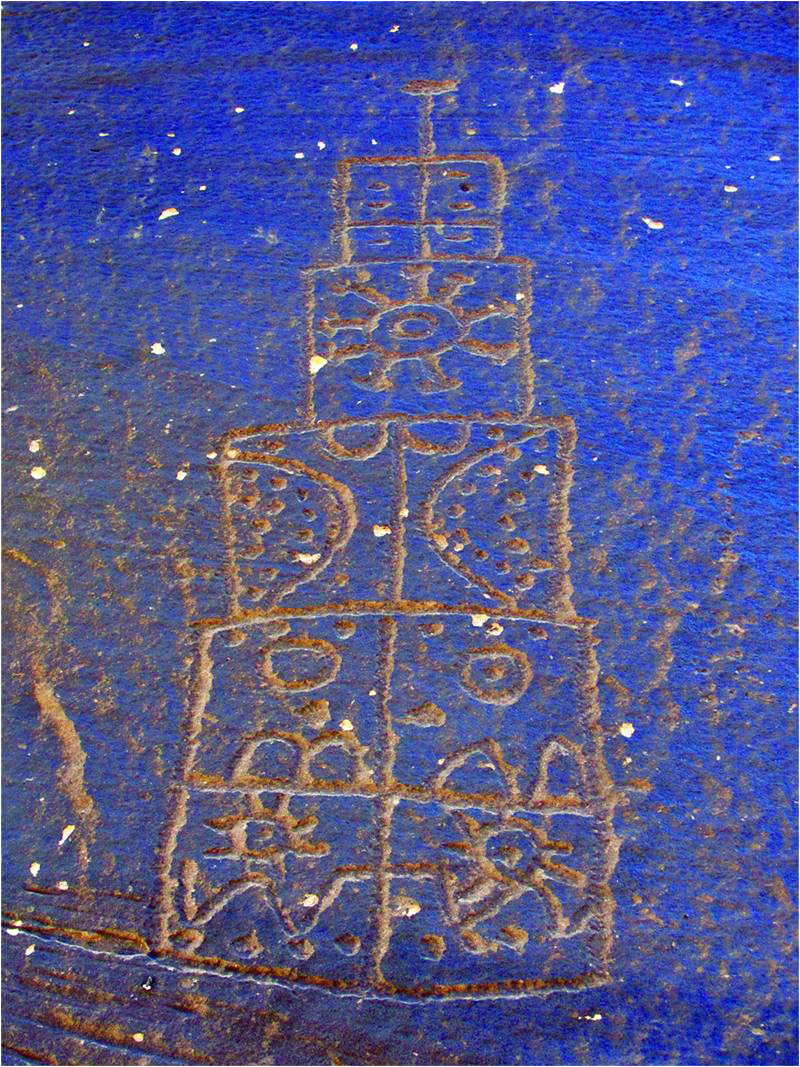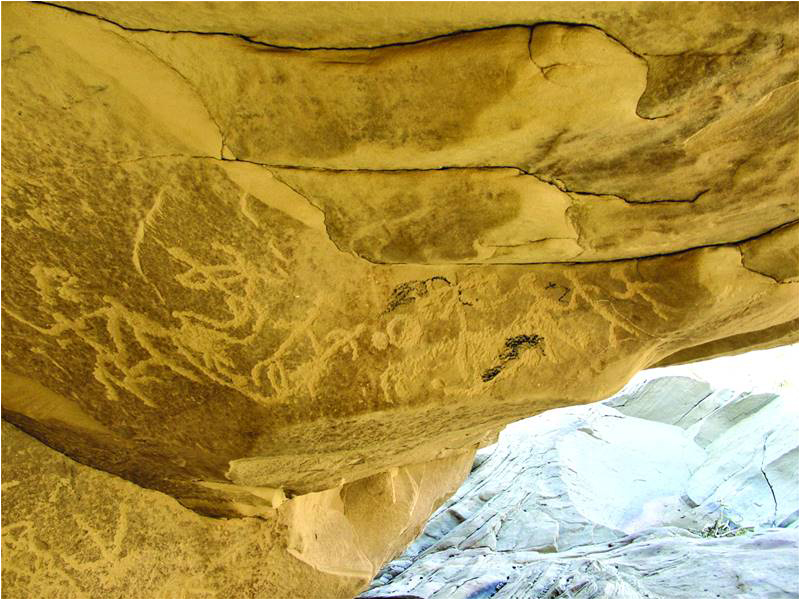
It is home to 13 rock-art sites, of which 6 are in the main Seeta Nai (valley) and seven in the sub-valleys (dhoras) of the valley.
Zulfiqar Ali Kalhoro
The Seeta valley in Khirthar Mountain Range is located about 100 km west of Larkana town. It is home to 13 rock-art sites, of which 6 are in the main Seeta Nai (valley) and seven in the sub-valleys (dhoras) of the valley.
The first rock art site is located at the mouth of the Seeta valley, locally called Seeta Dath rock art site. There are isolated boulders at this site bearing petroglyphs. There are total of six boulders depicting images of animals, humans and buildings. As one approaches the Dath (literally meaning jaw) of the valley, one comes across the huge boulder with Stupa images. Both are tower-like stupas. On another boulder are engraved ibex and camel images which are of the medieval period and were drawn by travelers. Dancing scenes are also engraved on some boulders.
The most ancient petroglyphs are found at Chitan Wari Bhar (engraved cliff). This site is located at a walking distance from the Seeta Dath rock art site. There is a cliff which is fully covered with petroglyphs mainly of the prehistoric period. The cliff faces the west. Petroglyphs are present on the cliff 30 feet above the riverbed. There is a large horizontal panel containing images of animals, cattle and humans. On the left side or the northern side of the cliff, there are images of a wild bull with human figures which are shown with raised hands – as if they were worshiping or invoking some deity. There are at least five such petroglyphs of males with raised arms. This scene possibly represents a religious ceremony apparently invoking the deity for some boon either in the form of hunt. It is also likely that they call upon the help of the deity for the domestication of the bovid which is drawn close to the figures of males with raised arms. The depiction of the bull is unrealistic – with a large rectangular body and a short head. There are almost non-existent legs which appear to be attached to the body of the bull. The horns, meanwhile, are drawn large in a crescent shape. Below the image of the bull and on the left side of the human figures with raised hands is the image of a woman who is shown giving birth to a child.

At a distance of few hundred meters from Chitan Wari Bhar is located the rock art site of the Kari Laki (meaning “black pass”). This was the abode of ancient artists who drew the figures at a height of 25-30 feet from ground level. It is a sandstone ridge with a black and brown patina. There are four panels on the Kari Laki. Three panels face the north while the fourth faces the west.
The first panel that faces the north is the most amazing petroglyph which represents a dancing scene. Six dancers are shown hand in hand before a masked figure – which appears to be their deity. One finds a ritual scene with seven females on the Indus seals too. But in the petroglyphs of Kari Laki, the artist only drew six dancers before the masked figure. It is likely that this is same legend that one finds on the Indus seals. The petrogylph of the masked figure is interesting. The body of the figure is triangular shaped and even the mask that the figure is wearing is triangle in shape with two lines – possibly representing horns – that rise from the left and right of the mask. One also finds masks in the petroglyphs of Seeta but masked figures are otherwise very rare in the rock art of Sindh. There are only three specimens in the rock art of Seeta valley where one finds masked figures. The figure which is drawn at Chitan wari Bhar is also shown wearing mask. However, the mask of the figure that is drawn at Kari Laki is most complex and interesting. Another interesting feature of the masked figure is an object that it is holding in its right hand, possibly a magical wand. All the dancers are shown standing on the base. One can figure out from the bun of the dancers that they are the female not the male.
The second panel, which faces north, depicts some startling petroglyphs. It has a wild bull which is shown striking the female. A man behind the wild bull is depicted crying with his hands raised up. This shows that the bull was not domesticated at that time. Close to these engravings are two other panels. Both panels face north and depict ibex images. The ibexes are shown with joined legs. They are also shown with small heads, large horns and prominent genitals. All these petroglyphs are made by pecking technique.

Apart from the four panels facing the north, there is one large panel which faces the west. This panel only depicts zoomorphs. Ibexes are in the majority. All the ibexes are shown with large horns and prominent sexual organs. There is also a depiction of a wild bull in the same panel. The horns of the bull are shown forward as if it were going to gore something. There is also a petroglyph of a camel. Two jackals are also shown in a separate panel close to the large one.
The Shaho Kumb rock art site is 500 meters from Kari Laki. There are only two petroglyphs of a Bactrian camel and stupa on the cliff facing the south.
Located about 400 meters from Shaho Kumb is rock art site of Hayar Kumb. There are few petroglyphs on the flat rock surface which lies on the left bank of Seeta Nai. Here a large amount of water accumulates at Hayar which is locally called Kumb. There are total of eight petroglyphs at Hayar Kumb.
As one goes up, the valley becomes narrow. However, at Beelo Kumb it becomes much wider again. There are a few rock shelters at Beelo Kumb which serve as a refuge for travelers and shepherds from the scorching sun in the hot summers. There are two rock shelters which are covered with petroglyphs. One of the rock shelters faces the east and the other faces the west. One finds animals’ images, fighting scenes and dancing scenes on the eastern one. Buddhist stupa images are also found on the rock shelter.
______________________
 Zulfiqar Ali Kalhoro is an anthropologist and author of 12 books including ‘Symbols in Stone: The Rock Art of Sindh’, ‘Perspectives on the art and architecture of Sindh’, ‘Memorial Stones: Tharparkar’ and ‘Archaeology, Religion and Art in Sindh’. He may be contacted at: zulfi04@hotmail.com
Zulfiqar Ali Kalhoro is an anthropologist and author of 12 books including ‘Symbols in Stone: The Rock Art of Sindh’, ‘Perspectives on the art and architecture of Sindh’, ‘Memorial Stones: Tharparkar’ and ‘Archaeology, Religion and Art in Sindh’. He may be contacted at: zulfi04@hotmail.com
Courtesy: The Friday Times Lahore